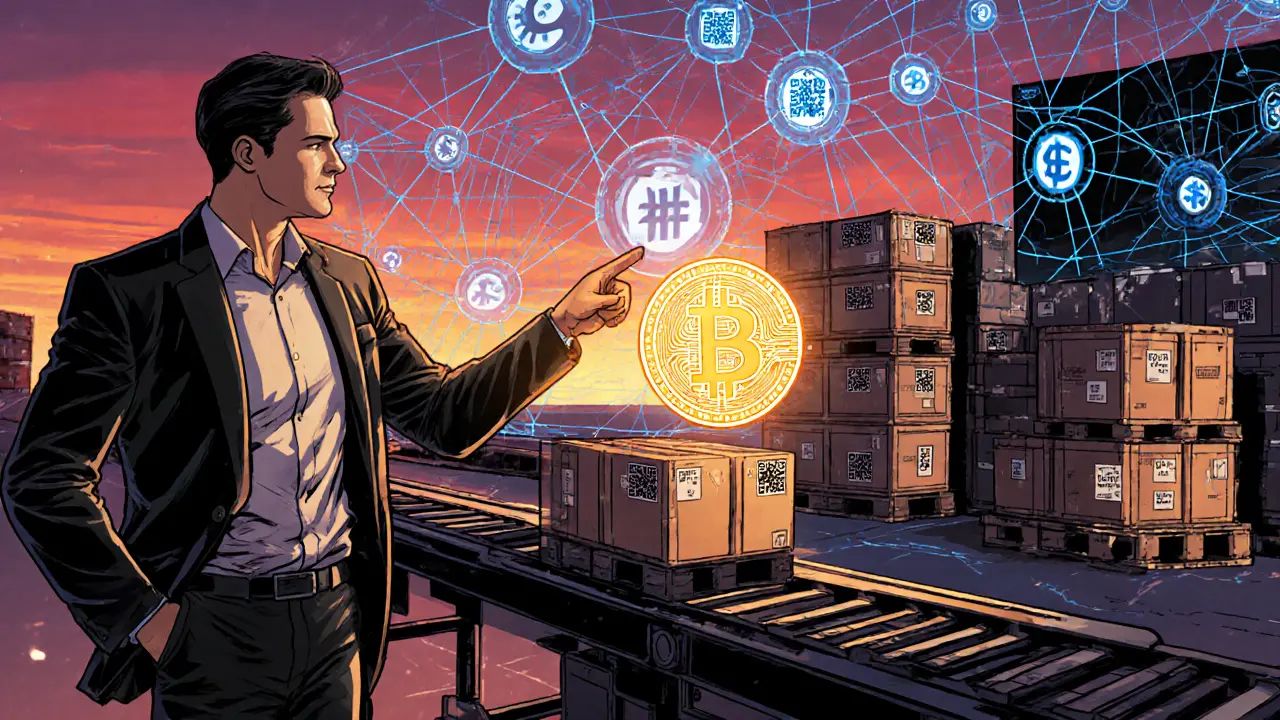Supply Chain NFT Implementation Challenge Calculator
Implementation Risk Assessment
Recommendations
Based on your inputs, here are some tailored recommendations for implementing NFTs in your supply chain.
Supply chain NFT challenges are on every executive’s radar as they weigh the promise of immutable product records against steep integration costs. Below you’ll find the most common roadblocks and practical ways to move past them.
TL;DR
- Technical hurdles: interoperability, data standardization, and high integration costs.
- Organizational issues: stakeholder buy‑in, skill gaps, and uneven cost distribution.
- Regulatory uncertainty: fragmented rules, cross‑border compliance, and lack of industry standards.
- Successful pilots focus on narrow use‑cases, clear KPI tracking, and multi‑party governance.
- Start with a proof‑of‑concept, then scale using open standards and shared infrastructure.
What is a Supply Chain NFT?
When you first hear NFT (Non‑Fungible Token) linked to a product, think of a digital passport that never changes. The token lives on a blockchain a decentralized ledger that records transactions in an immutable way. For a shoe, the NFT might store the leather type, factory ID, shipping route, and a QR code that consumers scan at the store. In supply‑chain terms, the NFT becomes the single source of truth for provenance, authenticity, and journey data.
Why Companies Are Eyeing NFTs
Two trends are converging: a demand for traceability the ability to follow a product from raw material to shelf, and the rise of smart contracts self‑executing code that enforces business rules on the blockchain. Together they promise faster customs clearance, reduced counterfeiting, and a new way to prove sustainability claims. A 2022 McKinsey study showed firms that digitized key logistics steps saw up to 30% productivity gains, and a 2025 survey predicts $11billion in blockchain investment for supply‑chain use‑cases.
Technical Barriers
Interoperability tops the technical list. Most pilots run on private chains (Hyperledger, Quorum) while larger partners still rely on legacy ERP systems. A 2024 Gartner report found 30% of firms struggle to connect blockchain nodes to their existing TMS or WMS platforms. Without open standards-think GS1 Digital Link the universal QR format that ties a physical barcode to a digital record-data silos persist.
Next, data quality and standardization matter more than the token itself. An NFT that records a temperature reading is useless if the sensor’s units differ across regions. Companies spend up to 40% of project budgets cleaning and normalizing data before it ever reaches the chain.
Finally, cost and scalability are real concerns. Public blockchains charge gas fees that can surge during network congestion, while private solutions demand costly node infrastructure and ongoing maintenance. A mid‑size manufacturer that tried to token‑ize every pallet found the per‑transaction cost exceeded its marginal profit on each unit, forcing a pivot to tokenizing only high‑value items.

Organizational Hurdles
Getting the whole network on board is harder than coding a smart contract. Stakeholder consensus agreement among suppliers, carriers, customs, and retailers on data sharing and governance often stalls projects. In a 2023 case study, a consortium of five seafood exporters spent 18months just negotiating who would host the ledger and who would bear the operating costs.
The skill gap is another blocker. Supply‑chain teams are experts in logistics, not cryptography. Training programs that teach “blockchain basics” and “NFT lifecycle management” can cost $15000 per employee and still leave gaps in understanding how token immutability interacts with privacy regulations.
Finally, the cost allocation model is rarely clear. Should a port authority pay for node hosting? Does a retailer finance the QR‑code printing? Without a transparent framework, partners may default to “we’ll wait until someone else pays.”
Regulatory Uncertainty
Unlike crypto‑trading, the use of NFTs for logistics sits in a gray zone. Some jurisdictions classify NFTs as digital assets, triggering AML/KYC rules; others treat them as mere data records, exempt from financial regulation. The European Union’s forthcoming Digital Identity Regulation a draft law that could define standards for blockchain‑based product IDs is still under debate, leaving multinational firms guessing.
Cross‑border shipments amplify the problem. A token created on a U.S. private chain must be recognized by customs in Singapore, the EU, and Brazil, each with different data‑retention mandates. The lack of a unified interoperability protocol standard that translates token data across blockchain networks makes compliance a moving target.
Real‑World Snapshots
Luxury sneakers: A leading brand launched a limited‑edition line where each shoe carried an NFT detailing leather source, stitching factory, and shipping route. Fans could scan a QR code to verify authenticity, reducing counterfeit sales by 12% in the first quarter. However, the brand reported a 20% increase in IT spend to integrate the token system with its existing ERP.
Recycling industry: A European consortium tokenized batches of reclaimed aluminum. The immutable record helped manufacturers prove recycled content to eco‑certifiers, unlocking premium pricing. Yet, small‑scale recyclers struggled to meet the data‑entry requirements, causing a bottleneck that delayed batch releases.
Food supply: An Asian conglomerate pilot‑tested NFTs for fresh produce, embedding farm‑level temperature data. While the pilot showed a 15% reduction in spoilage, it also exposed that many small farms lacked internet connectivity, forcing a hybrid paper‑digital approach.
How to Overcome the Barriers
Start small, scale fast. Choose a high‑value, low‑volume product (e.g., pharmaceuticals, luxury goods) for the first token rollout. Define clear KPIs-time‑to‑verification, counterfeit reduction, cost per token-and measure them rigorously.
Leverage open standards. Adopt GS1 Digital Link the standardized QR format that links physical items to a digital record on any blockchain and the emerging W3C Verifiable Credentials a framework for issuing cryptographically signed statements about products. These reduce custom integration work and improve interoperability.
Build a shared governance model. Form a consortium with clear rules on who hosts nodes, who pays for maintenance, and how data‑privacy is handled. A governance charter should spell out dispute‑resolution procedures and a roadmap for onboarding new partners.
Invest in talent and tooling. Upskill existing logistics staff with blockchain fundamentals, and hire at least one dedicated blockchain architect. Low‑code platforms that abstract smart‑contract development can lower the technical entry barrier.
Engage regulators early. Schedule pre‑submission meetings with customs agencies and data‑privacy authorities. Demonstrating a compliance‑by‑design approach-such as encrypting personally identifiable information within the NFT-helps avoid costly retrofits.
Implementation Checklist
- Define the product scope and success metrics.
- Select a blockchain platform that matches scalability and privacy needs.
- Adopt GS1 Digital Link and map data fields to token attributes.
- Draft a consortium governance charter covering cost sharing and node hosting.
- Run a pilot with a single SKU; collect KPI data.
- Iterate based on pilot feedback; expand to additional partners.
- Document compliance steps and submit a regulatory briefing.

Frequently Asked Questions
Do NFTs replace existing barcodes?
No. NFTs usually sit on top of traditional barcodes or QR codes. The physical code points to the digital token, so you keep the familiar scanning workflow while adding an immutable data layer.
What are the main cost drivers?
Infrastructure (node hosting), smart‑contract development, data‑cleaning, and ongoing governance. For a mid‑size pilot, total spend can range from $150k to $500k depending on integration depth.
How does a private blockchain differ from a public one for supply chains?
Private chains give participants control over who can read or write data, which eases compliance with data‑privacy laws. Public chains offer broader network effects but expose transaction metadata and can incur volatile gas fees.
Can NFTs help with sustainability reporting?
Yes. By embedding carbon‑footprint data, recycling‑rate information, or certifications into the token, brands can provide auditors and consumers with verifiable proof of sustainability claims.
What regulatory steps should I take before launching?
Identify the jurisdictions involved, map data‑privacy requirements (GDPR, CCPA, etc.), and consult with customs authorities. Prepare a compliance‑by‑design documentation that shows how PII is encrypted or omitted from the NFT.



Matt Potter
August 10 2025Jumping into NFTs can feel like stepping onto a moving treadmill, but the payoff is huge when you lock provenance into an unchangeable ledger. Companies that pick a pilot with high‑margin goods see ROI within six months, so grab the chance and start small.
Marli Ramos
August 17 2025lol this whole nft hype is kinda overdone 🙄
Christina Lombardi-Somaschini
August 24 2025It is imperative to recognize that the integration of non‑fungible tokens within supply‑chain architectures necessitates a rigorous alignment of data standards; without such alignment, the purported immutability of blockchain records becomes merely ornamental. Moreover, stakeholders must conduct a comprehensive audit of legacy ERP systems to ascertain compatibility, thereby averting costly retrofits. In addition, the governance framework governing token issuance should be codified in a consortium charter, delineating responsibilities, cost‑sharing mechanisms, and dispute‑resolution protocols. Finally, regulatory compliance cannot be an afterthought; early engagement with customs authorities and data‑privacy regulators ensures that the tokenization strategy adheres to jurisdictional mandates.
katie sears
September 1 2025Building on that, it helps to map each physical attribute-such as country of origin or material composition-to a well‑defined schema like GS1 Digital Link, which many industries already trust. By doing so, you create a common language that eases cross‑border recognition and respects cultural nuances in labeling practices.
Gaurav Joshi
September 8 2025Implementing NFTs without addressing the ethical implications of data ownership is unacceptable. Companies must ensure that the data embedded in tokens does not violate privacy rights and that all participants consent to the immutable record keeping.
Kathryn Moore
September 16 2025In fact the blockchain simply records hashes of data not the data itself which mitigates some privacy concerns.
Christine Wray
September 23 2025From a practical standpoint, the biggest win for many firms has been the reduction in counterfeit claims after a simple QR‑code linked to an NFT was added to high‑value items.
roshan nair
September 30 2025To replicate that success, start by selecting a token standard-ERC‑721 or ERC‑1155- that aligns with your asset granularity. Then integrate a middleware layer that pulls data from your ERP, formats it according to the chosen schema, and pushes the hash onto the chain. This approach abstracts the complexity and lets your logistics team focus on core operations rather than smart‑contract code.
Jay K
October 8 2025Additionally, ensure that the node infrastructure is hosted in a jurisdiction with stable regulatory policies to avoid unexpected compliance burdens.
Kimberly M
October 15 2025Even small suppliers can join the network by using lightweight client wallets, which keeps costs down and promotes inclusivity 😊
Navneet kaur
October 23 2025But if you let anyone in without vetting they will leak data and cause problems.
Marketta Hawkins
October 30 2025US manufacturers should prioritize domestic blockchain solutions to avoid foreign data exposure and keep the supply chain sovereign 🛡️
Drizzy Drake
November 6 2025Hey, I hear you loud and clear about keeping things homegrown, and that vibe definitely resonates with a lot of folks who worry about data hopping overseas.
At the same time, the reality of global supply chains is that raw materials, components, and logistics already cross borders faster than a tweet goes viral.
If you lock yourself into a purely domestic blockchain, you might end up with higher latency and limited peer participants, which can hurt the very efficiency NFTs promise.
On the other hand, a hybrid model lets you keep sensitive provenance data on a private network while still leveraging public verification for transparency.
Think of it like a safe deposit box inside a public library – the valuables stay locked, but the proof of existence is visible to everyone.
Companies that tried a fully private chain often ran into scaling headaches when the number of partners grew beyond a dozen.
They had to spin up extra nodes, negotiate new inter‑company SLAs, and suddenly their IT budget ballooned.
Meanwhile, those who adopted a public‑first approach faced gas fee spikes during network congestion, which ate into margins on low‑value items.
The sweet spot, in my experience, is to start with a proof‑of‑concept focused on high‑value, low‑volume goods like luxury watches or pharma batches.
Use a permissioned layer for the detailed metadata, and expose only a hash on a public chain for auditability.
This way you get the best of both worlds: compliance, speed, and a dash of global trust.
Of course, you’ll still need a solid governance charter that spells out who pays for node hosting and who owns the cryptographic keys.
Bring legal, IT, and the supply‑chain ops team together early, because silos are the biggest roadblock in any NFT rollout.
And don’t forget to train the on‑ground staff – a scanner is only as good as the person who knows what to scan.
In the end, whether you go all‑American or go global, the focus should stay on reducing counterfeit risk and delivering real value to the end consumer.
AJAY KUMAR
November 14 2025Our nation’s pride depends on protecting our supply chain DNA from foreign interference, so an indigenous blockchain is the only patriotic choice.
bob newman
November 21 2025Sure, because the only thing stopping global elites from hijacking our data is a shiny logo on a token, right? 🙃